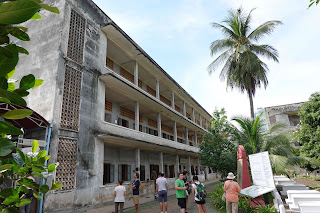It’s an unusually cool overcast morning as we board the van for the ride to the turquoise-blue pools of the Kuang Si waterfalls south of Luang Prabang. Although it’s only 29 kilometers, the ride is bumpy and dusty in the crammed van and takes over an hour because of the bad road.
Things start out great, our van and driver arrive at our
hotel on time, which is a surprise because we’re getting used to living on laid-back Laos
time. Even better, the van is just like the new one in the travel agent's photo
and identical to all the other hundreds of vans parked on all the streets in Luang
Prabang waiting for their tourists to emerge from their hotels or their temple
tour—shiny silver/grey and new.
The travel agent we had booked with told us only five others
had signed up for the tour. But we are the only ones in the van as the driver heads
south out of town towards the falls. Lucky us!
Ten minutes later, on the outer edge of town, the driver takes a call, suddenly pulls
off the road, turns around and takes us back to our hotel. What? He has picked
up the wrong customers. Twenty long minutes later, we hop into our new van and then drive around town picking
up other clients for 15 minutes. Here's the other five, I think. No, abruptly, we're dropped off at a central staging
area where we are crammed into the last two seats of an already full van with
15 others. WTF!
I’m not happy! I’m squeezed into the last rear seat—the
bumpiest—with two Chinese tourists, one of whom begins to fall asleep on my
shoulder, and a lovely young woman from Poland who is touring Asia on her own
for four months. In very good English, she explains that she quit her job back
home to discover Asia. Everything is an adventure for her. She's too excited to be sleepy, even at this early hour. I'd say her enthusiasm is infectious, but I'd be lying. The bench is too small, I'm crowded in between two people and the rear of the bus is bucking like a bronco.
But in spite of the bumpy, crowded, stuffy ride we arrive safely, if bruised, at the Kuang Si falls and fall in love. The Kuang Si falls more than live up to their star attraction billing. The gushing falls start in shallow pools
on top of a steep hillside of shiny limestone and drop 200 feet into the first of several
turquoise-blue shimmering pools. Then a series of cascading falls meanders down
through the glistening rock. Gorgeous doesn't begin to describe the colour!
Along the trail leading to the falls we pass through the Tat
Kuang Si Bear Rescue Centre run by the Free the Bears organization. They created a rescue operation in Luang Prabang in 2003. Their goal is to preserve and
protect endangered Moon Bears from poachers and from those who use bears as pets, for
entertainment, or for the collection of bile. Why???
First off, I didn’t even know they had bears in Laos, let alone Moon Bears. They’re really cute. Then we learn that they are
almost as big as our Canadian black bears. Cute and dangerous? Who knew!
The sad thing, however, is that in Asia, especially in China
and Vietnam, captured bears are kept in coffin-like cages, unable to move,
while bile is painfully extracted from their gall bladders through a catheter.
Bear bile is used in traditional Chinese medicine. Again, why? Bear bile, bear paws,
shark fins? Why?
Happily, Free the Bears rescued 10 Moon Bears in 2017 and
another 10 in 2018. They now have managed a total of 60 bear rescues in Laos alone since 2013. At
the rescue centre they build bear houses, play areas and resting platforms,
nurse the bears back to health and let them lead somewhat normal lives.
Hunting the protected Moon bears is illegal, but recently
the project removed over 1,000 snares in just three months.
For a small donation, I buy a Free the Bears t-shirt to
support the cause. You can help to, by going to https://freethebears.org.
How bumpy was the ride to the falls? The ride was so bad that at the end
of the tour five of the original passengers opted to hire tuk tuks for the ride back to
Luang Prabang rather than cram into our van again. But as I’ve said before,
sometimes you have to suffer a little for special moments. And besides we had
more room on the way home.




























































